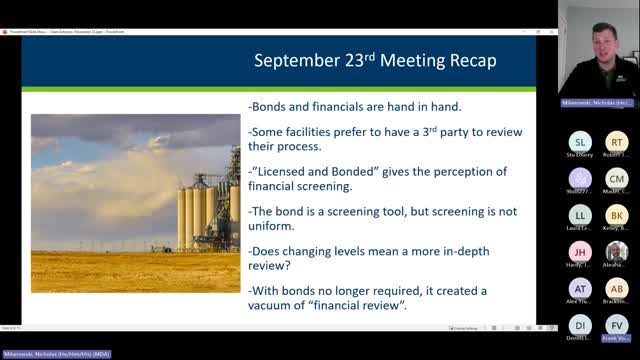Advisory Group Discusses Bonding Requirements and Financial Review Gaps for Grain Companies
November 16, 2023 | Agriculture, Department of , Agencies, Boards, & Commissions, Executive, Minnesota
This article was created by AI summarizing key points discussed. AI makes mistakes, so for full details and context, please refer to the video of the full meeting. Please report any errors so we can fix them. Report an error »

During the recent Grain Advisory Group meeting held by the Minnesota Department of Agriculture, significant discussions centered around the implications of bonding requirements for grain facilities. The meeting highlighted concerns regarding the financial screening processes that are currently in place, particularly following the implementation of the indemnity fund.
One of the key points raised was the drastic difference in bond amounts, which can range from as low as $10,000 to as high as $500,000. Participants expressed that the lower bond amounts may not incentivize thorough financial reviews by surety companies, leading to a potential lack of oversight in the industry. This situation creates a "vacuum" where financial assessments are not consistently conducted, raising concerns about the financial stability of grain buyers and sellers.
Members of the advisory group noted that while some companies submit detailed financial information for review, others merely pay the bond amount without any further scrutiny. This inconsistency has led to a false sense of security among stakeholders, as not all bonded entities are held to the same financial standards. The discussion emphasized the need for a more uniform approach to bonding that could ensure better financial oversight across the board.
The group considered whether increasing bond levels could compel surety companies to conduct more rigorous evaluations of the businesses they insure. This potential change aims to enhance the reliability of the bonding system as a screening tool, ensuring that all licensed grain facilities are subject to similar financial scrutiny.
As the meeting concluded, participants were encouraged to share additional thoughts on the topics discussed, indicating an ongoing commitment to refining the bonding process and improving financial oversight in Minnesota's grain industry. The outcomes of these discussions could have lasting implications for the stability and trustworthiness of grain transactions in the state, ultimately affecting local farmers and the agricultural community at large.
One of the key points raised was the drastic difference in bond amounts, which can range from as low as $10,000 to as high as $500,000. Participants expressed that the lower bond amounts may not incentivize thorough financial reviews by surety companies, leading to a potential lack of oversight in the industry. This situation creates a "vacuum" where financial assessments are not consistently conducted, raising concerns about the financial stability of grain buyers and sellers.
Members of the advisory group noted that while some companies submit detailed financial information for review, others merely pay the bond amount without any further scrutiny. This inconsistency has led to a false sense of security among stakeholders, as not all bonded entities are held to the same financial standards. The discussion emphasized the need for a more uniform approach to bonding that could ensure better financial oversight across the board.
The group considered whether increasing bond levels could compel surety companies to conduct more rigorous evaluations of the businesses they insure. This potential change aims to enhance the reliability of the bonding system as a screening tool, ensuring that all licensed grain facilities are subject to similar financial scrutiny.
As the meeting concluded, participants were encouraged to share additional thoughts on the topics discussed, indicating an ongoing commitment to refining the bonding process and improving financial oversight in Minnesota's grain industry. The outcomes of these discussions could have lasting implications for the stability and trustworthiness of grain transactions in the state, ultimately affecting local farmers and the agricultural community at large.
View the Full Meeting & All Its Details
This article offers just a summary. Unlock complete video, transcripts, and insights as a Founder Member.
✓
Watch full, unedited meeting videos
✓
Search every word spoken in unlimited transcripts
✓
AI summaries & real-time alerts (all government levels)
✓
Permanent access to expanding government content
30-day money-back guarantee

